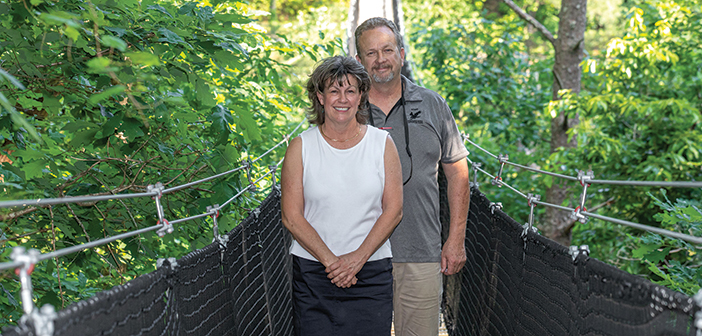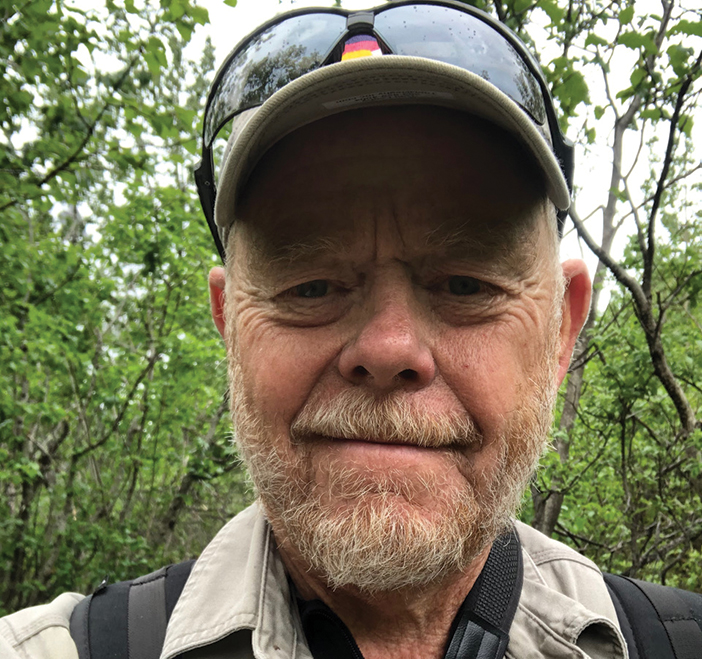The last few years have been full of surprises. For one: An unanticipated uptick in revenue for adventure parks in 2021 boosted profit margins (mostly) across the board, even though visits were down, according to the Adventure Park Insider State of the Industry Report. Consumers with newfound time and interest in the outdoors led the charge—and still are—bringing optimism to the aerial adventure industry.
The continuing trend has spurred growth—sometimes unexpectedly—in all markets. Builders are working around the clock to meet demand, while dealing with other issues du jour, including staffing and a sluggish supply chain. With this new normal, what do operators’ outlooks and expectations look like, and how are builders answering? API engaged with five builders to discuss.
Growth vs. Expectations
Despite predictions that adventure park consolidation and closures were on the horizon, new construction is way up, with many operators looking to expand or build new projects and park builders busy across the board.
“We have definitely seen the desire for current operators to grow their existing operations,” says Mike Holder, founder of American Adventure Park Systems. “The basic theme we found from 2021 was the problem of not being able to keep up with the amount of people wishing to participate in the activity. Almost everyone had records broken.”

Mike and Donna Holder, American Adventure Park Systems
Keith Jacobs, president at Experiential Systems, notes the same. “We are the busiest we have ever been with new builds,” he says, “and they are primarily all new activity centers for organizations, so they can accommodate either more outdoor activities or more guests entirely.”

Keith Jacobs, Experiential Systems
Likewise, at Challenge Towers, where new builds are up—and larger than in the past, says founder Ken Jacquot. “Most operators are bullish on expanding their capacity, and also to differentiate themselves from the competition,”
says Jacquot.

Ken Jacquot, Challenge Towers.
“Our owners/directors have a lot of energy going into this season and are already looking for new things to incorporate for 2023,” adds Don Stock, president of The Adventure Guild.

Don Stock, The Adventure Guild.
No Market Left Behind
Builders say they’re receiving inquiries from all directions: new parks, park expansions, camps, and commercial operations.
At Challenge Towers, “we are seeing design and installation services in all markets,” confirms Jacquot. “Our commercial clients are going big. Camps and rec centers are expanding, upgrading, and addressing delayed maintenance.”
Jacobs says his company has projects in all of these categories right now, too. “It’s a pretty close split between commercial (quasi-commercial) and traditional camp programs,” says Jacobs. “It appears that organizations are looking for more outdoor activity space and program areas.”
“Over the past few years, we have seen a lot of repair, modifications, upgrades, and new installs,” adds Holder. “Our potential new install pipeline was certainly disrupted in 2020 but has since continually grown, as potential new operators have seen the potential for outdoor recreation and event centers since the re-opening following the lockdowns.”
Selective business. The Adventure Guild has gotten inquiries from all markets as well, and, according to Stock, is using the windfall as an excuse to be picky. “Over the past several years, we have strategically leaned into the camp market versus the commercial realm, due mainly to our lack of desire to live on the road,” says Stock. “Our camp clients are looking for all kinds of projects, and we’re already starting to book into the fall.”
Tom Leahy, president of Leahy & Associates, says he’s recently “retired” from installation and is instead focusing on design, inspection, and training. For Leahy, who’s recently designed four large courses that he’s bid out to peers in the field, profits are up, and “facilitated” courses still comprise the majority of his business. “These clients are camps, therapeutic, religious, and a high-end conservation and hunting resort,” he notes.

Tom Leahy, Leahy & Associates.
What’s In, What’s Out
So what’s being built? Zip tours? Aerial trekking? Multi-activity parks? Challenge courses? All of the above, say builders.
Smart tech. Challenge Towers has seen requests across the board. “This is an expansion across all sectors and types of programs,” says Jacquot. “The use of smart technology and higher throughput are [specifically]in demand.”
Holder notes huge participation numbers, combined with hiring issues, created a tough situation for some parks, one that spurred specific requests. “For aerial courses, an easy upgrade to help minimize staff needed would be that of a smart or continuous belay system,” he says. “We have retrofitted multiple courses to this end.”
Courses and towers. Experiential Systems is primarily installing aerial parks and ropes courses with several climbing towers, including a custom tower that can be used by the YMCA that mimics its current logo shape and color. “While we have seen interest in zip lines/tours, this currently represents a small amount of our 2022 workload,” says Jacobs.
Stock says The Adventure Guild has been building a lot of challenge courses, as well as a fair number of tree houses for camp clients. “This year we launched a new brand of obstacle courses for our camp clients [called NinjObstacle], which is a take on the ninja warrior course, only we design them for camp programs and build from wood rather than steel structures to better fit their motif.”
Supply Chain Issues
Persistent global supply chain issues, unlikely to abate any time soon, combined with the increased demand has had ripple effects on purchasing practices and delivery timelines.
Longer lead times. “Resourcing materials, hardware, and gear needs to be projected much further out nowadays, which can push back contract to action to completion dates,” says Holder. “From our manufacturer perspective [Vertical Trek Innovations], we are trying to project and stay around seven months ahead on all hardware.” Most clients are understanding, he says.
Stock is experiencing the same lead-time issue on most fronts. “Sometimes it’s hardware and poles, at other times it’s gear and equipment,” he says. “We’ve been trying to order ahead on things we know we always use and sell so that we have them on hand when we need them.”
He acknowledges that’s easier to do with harnesses and wire rope than, say, poles and lumber. But even gear can pose a challenge. “For gear, we’ve had to branch out beyond the regular brands that we’ve historically used, because recently we’ve seen lead times on things like steel carabiners that are four to six months out,” says Stock. “Every project is a new adventure that we have to navigate.”
Forced limitations. “We are dealing with limits to our ability to service the needs of our clients and new opportunities,” adds Jacquot. “Staffing, materials, and resources are impacting our ability to deliver on the increasing demand. We have also been warehousing material for known projects.”
Jacobs says that Experiential Systems has mostly avoided supply chain issues with a bit of advance planning. “We purchased almost all materials we needed for 2022 at the end of 2021 [poles, anchors, carabiners, harnesses, rope, etc.], maintain a facility large enough to bring it in or have contracted with our suppliers to shelf and ship when needed, and are booked sufficiently out for construction services,” he says. “The only issues that exist in this category for us is in unanticipated equipment sales or maintenance needs”—typically around specific single-brand products like auto belays, harnesses, etc.
“Many of these issues can be addressed with substitutes for other brands, but for a few product lines, the clients just need to be patient,” says Jacobs.
Staffing Shortages
Labor shortages have become another reality of business today. With the national unemployment rate as low as it has been, most builders say they are struggling to find enough workers to accommodate their uptick in business. (A good problem to have, say glass-half-full folks.)
No response. Stock says The Adventure Guild has placed multiple ads for staff, including a video ad through its YouTube channel, that got zero response. “The same is true in our efforts to hire facilitators for the program arm of our company,” he says. “It doesn’t matter how much we offer to pay, etc. No response.”
Building and maintaining strong staff is a never-ending challenge, Holder acknowledges. He says American Adventure Park Systems has been lucky to maintain a strong core group.
At Challenge Towers, “We have expanded our outreach for qualified people and simultaneously are growing from within,” adds Jacquot.
At Experiential Systems, Jacobs says the team remains intact for the most part, though the plan is to hire additional skilled installers in the months to come as permits materialize. He believes company culture and wage scales will help this attempt, as will a healthy dose of reality.
“We don’t expect to find the perfect employee, and so we budget for training and development, including industry certifications for the right individuals,” says Jacobs. This includes moving experienced employees up into inspection and management roles and hiring and training new talent in the installation department. “These people are out there looking for work, they just expect good pay, benefits, and work culture that allows for travel and a balance of time back home.”
Meeting Demand
“With the reality of 2022, it takes longer nowadays to go from concepts to fully install-ready,” says Holder. “We try to drive pre-planning projects throughout the year, so the install team is able to bounce from one to the next with as little separation as possible.”
The rapid demand for new outdoor spaces creates more of a “when can you get the project done?” market, adds Jacobs. “With time being the urgent factor over project cost.”
Might the boom mean an increased possibility of under-qualified/less-experienced folks getting more work? Perhaps, says Stock. “There has always been a percentage of folks out there who are less competent or professional, but I think the current situation could result in more folks getting bad projects or having bad experiences due to the limited availability of established, professional builders,” he notes. “It could result in more good firms emerging, but only time will tell.”
Leahy sees room for improvement. “It is clear that my peers have too much business, too few builders, and not enough qualified trainers,” he says. “I continually have potential clients calling me for inspections and trainings because the vendors who installed their $500,000-$1,500,000 courses now lack the time to get inspections and training done due to their lust for new projects.”
Outsource properly. Experiential Systems has long realized that the art is often in the development of the proper design and sourcing of materials, says Jacobs. “Our company has, for a long time, hired qualified subcontractors to do what they are good at: installing poles, carpentry, iron work, etc., and local day laborers are available in any market to lift, move, and help pull things into place when skilled laborers are in short supply.” The key? The design and engineering team, the project manager(s), and the ongoing and final inspection of the work, and a qualified trainer.
Ultimately, the current level of demand should be a cause for celebration in the industry. “I don’t see increased demand as a concern,” says Jacquot. Echoing Jacobs’ approach, he notes, “There are a few ways to deal with capacity issues. You could subcontract certain non-aerial aspects like decking, stairs, or setting of poles, or work with other vendors on selected aspects of a larger project.”
“Let’s all celebrate our expanding and demanding world,” he says.






